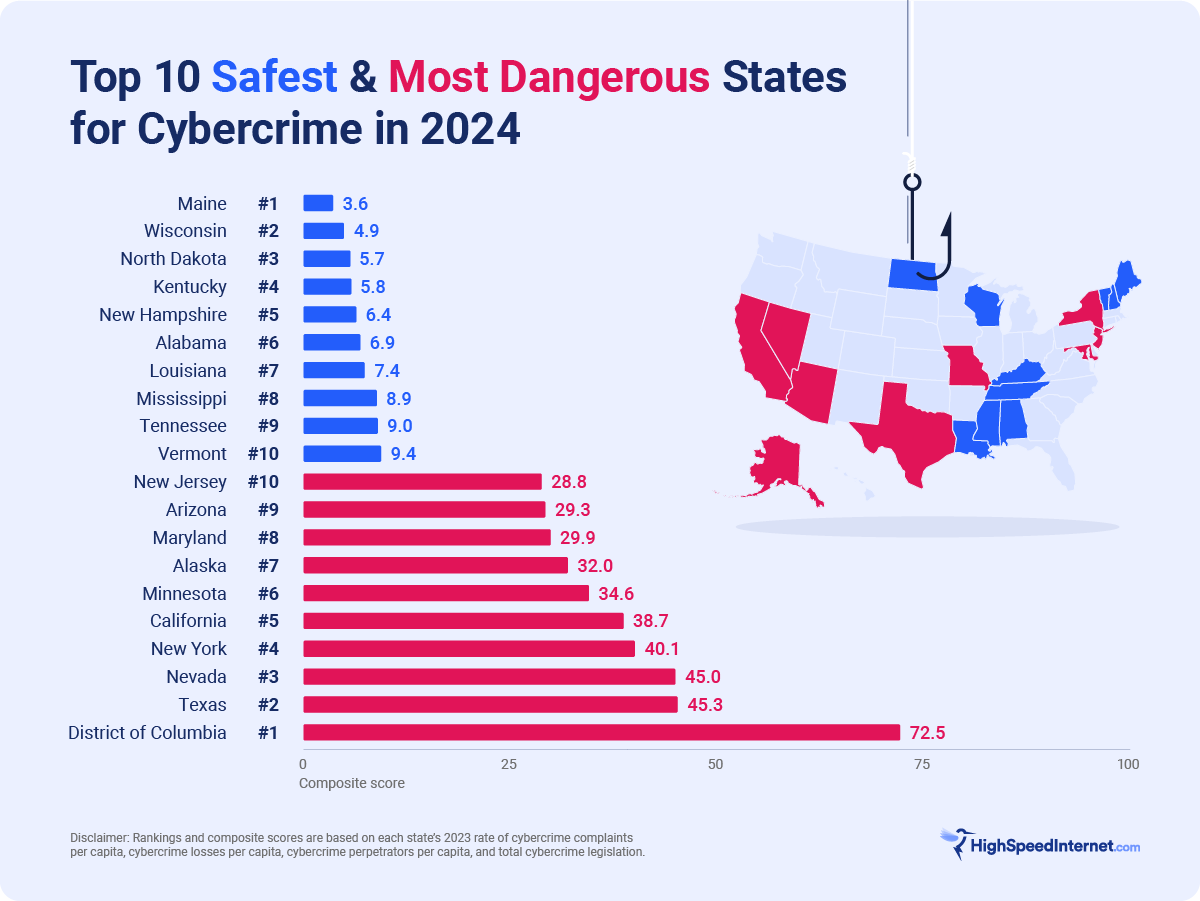The Safest and Most Dangerous States for Cybercrime in 2024
Sep 11, 2024 | Share
Industry Exclusive/Entertainment
You only have to glance through cybercrime headlines to see that online attacks are a constant, if not obvious, threat. Even simple online tasks, like logging into your bank or buying concert tickets, can expose your personal data, identity, and money to bad actors.
And, unfortunately, the boomers have borne the brunt of cybercrime more than any other age group. Younger generations who grew up with technology and are literate in internet safety are less likely to fall victim—but plenty still do.
To help build awareness around cybersecurity issues, we’ve ranked the nation’s worst cybercrimes by number of complaints and total financial loss. We’ll also illustrate which states are the most and least at risk for cybercrime by comparing cybercrime rates and legislative action designed to protect residents.
And to help save you from the latest scam, we’ll also provide resources on how to ensure you have a safe internet connection.

US loses billions to cybercrime every year
According to the Internet Crime Complaint Center (IC3)’s 2023 report, cybercrime amounts to billions in losses every year and affects millions:
- $12.5 billion losses in 2023
- 2,412 average complaints are received daily
- 758,000+ average complaints received per year
- Over 8 million complaints have been reported since the IC3’s inception
The most reported cyber crimes are phishing, personal data breaches (like your password or personal information getting leaked), and non-payment/non-delivery crimes (which is when one half of an exchange is never fulfilled, in either payment or delivery of goods or services).
The most common cybercrimes by number of complaints in 2023:
- Phishing/spoofing: 298,878
- Personal data breach: 55,851
- Non-payment/non-delivery: 50,523
However, in terms of financial loss, investment fraud takes the lion’s share at $4.5 billion lost in 2023. Victims 30 to 49 years old were the most likely group to report losses from investment fraud—likely due to the appeal of increasing wealth at a pivotal age when many are trying to build families, buy homes, and increase wealth before retirement.
Top cybercrimes by USD loss:
- Investment: $4,570,275,683
- Business email compromise (BEC): $2,946,830,270
- Tech support $924,512,658
Age also played a factor in the third biggest cyber crime designation, tech support: The elderly accounted for well over half of losses to tech support scams. In fact, people over the age of 60 filed the most complaints and reported the greatest cybercrime losses in 2023 at $3.4 billion.
Top 10 most dangerous states for cybercrime
Do you live in an area more prone to cybercrime? Well, if you live in the nation’s capital, you’re definitely more likely to be a target.
| Rank | State | Population | Complaints per capita | Losses per capita | Perpetrators per capita | Legislation count | Composite score |
|---|---|---|---|---|---|---|---|
| 1 | District of Columbia | 681,683 | 552.9 | $6,768,887 | 286.4 | 5 | 72.5 |
| 2 | Texas | 30,976,754 | 152.7 | $3,297,787 | 58.7 | 59 | 45.3 |
| 3 | Nevada | 3,210,931 | 308.1 | $6,259,715 | 106.0 | 9 | 45.0 |
| 4 | New York | 19,469,232 | 138.4 | $3,852,003 | 76.1 | 43 | 40.1 |
| 5 | California | 38,889,770 | 198.7 | $5,552,757 | 109.5 | 14 | 38.7 |
| 6 | Minnesota | 5,761,530 | 122.3 | $3,366,283 | 44.2 | 43 | 34.6 |
| 7 | Alaska | 733,536 | 318.7 | $4,331,250 | 66.4 | 5 | 32.0 |
| 8 | Maryland | 6,196,525 | 156.8 | $3,574,915 | 58.1 | 26 | 29.9 |
| 9 | Arizona | 7,497,004 | 221.2 | $4,326,430 | 67.1 | 10 | 29.3 |
| 10 | New Jersey | 9,320,865 | 131.5 | $4,732,943 | 49.7 | 18 | 28.8 |
- Washington, D.C., tops the list for most complaints per capita, most losses per capita, and most perpetrators per capita. Despite being the place where America’s legislation is made, the District has only five legislative acts protecting residents against cybercrime.
- Does more legislative action mean lower cybercrime? Not necessarily. Texas, New York, Minnesota, and Maryland all have dozens of cybercrime-related laws, but still come out to be some of the most dangerous places for cybercrime.
- Texas, Minnesota, and Maryland also had relatively low perpetrators per capita, but still faced great losses and plenty of complaints, showing a need for greater awareness.
- Is cybercrime only hitting the big cities and populated areas? While states with populations in the tens of millions and big metro areas, like Texas, New York, and California ranked in the top 10, so did Alaska, with a population of only 733,536. However, this seems to be the exception that proves the rule.
Cybercrime can affect virtually everyone, but increased population definitely seems to play a factor. You’ll notice below that the safest states for cybercrime have lower populations, mostly under 6 million people—with the exception of Tennessee at 7.2 million (which also lost the most out of the safest states at $2.2 billion lost in 2023).
Top 10 safest states for cybercrime
The safest states in the U.S. for cybercrime all had less than 130 complaints per capita and averaged about $1.6 million in losses. That’s still no small amount, but far less than the average of $4.6 million lost by the most dangerous states. None of the safest states had more than 100 perpetrators per capita. Fewer bad actors, fewer problems.
| Rank | State | Population | Complaints per capita | Losses per capita | Perpetrators per capita | Legislation count | Composite score |
|---|---|---|---|---|---|---|---|
| 1 | Maine | 1,402,106 | 116.0 | $1,352,863 | 31.8 | 2 | 3.6 |
| 2 | Wisconsin | 5,931,367 | 129.5 | $1,552,500 | 27.3 | 2 | 4.9 |
| 3 | North Dakota | 788,940 | 96.8 | $1,715,269 | 38.4 | 4 | 5.7 |
| 4 | Kentucky | 4,540,745 | 102.2 | $1,073,525 | 38.8 | 9 | 5.8 |
| 5 | New Hampshire | 1,405,105 | 117.4 | $1,934,252 | 33.7 | 2 | 6.4 |
| 6 | Alabama | 5,143,033 | 112.1 | $1,875,929 | 46.8 | 2 | 6.9 |
| 7 | Louisiana | 4,559,475 | 107.2 | $1,716,998 | 46.7 | 5 | 7.4 |
| 8 | Mississippi | 2,940,452 | 101.4 | $1,093,168 | 59.1 | 12 | 8.9 |
| 9 | Tennessee | 7,204,002 | 117.8 | $2,237,576 | 43.4 | 3 | 9.0 |
| 10 | Vermont | 647,818 | 107.7 | $1,361,213 | 92.3 | 5 | 9.4 |
- Maine stands out as the safest state for cybercrime by having an overall low count on complaints per capita, losses per capita, and perpetrators capital, achieving a very low cybercrime composite score 3.6 compared to D.C.’s 72.5.
- North Dakota came with the lowest number of cybercrime complaints per capita, while Kentucky had the lowest losses per capita.
- Despite having a lower population and a relatively high count of perpetrators per capita at 92.3, Vermont kept losses low at $1.36 million for 2023.
Cybercrime prevention tips
To help prevent cybercrime, we recommend the following:
- Update your devices, browsers, and apps regularly
- Use strong passwords and update them regularly
- Double-check your privacy and social media settings
- Don’t reply to or click on messages and links from unfamiliar senders
- Protect all passwords and personal information
- Monitor your computer and internet speeds for changes
For more information, check out our other internet-security resources:
Cybercrime can affect anyone, but it’s more likely to happen to you if you’re older and living in the nation’s capital and high population states.
Regardless of how old you are or where you live, you should know how to prevent, spot, and report cybercrime. We recommend reviewing the FBI’s Cyber Threat Resources along with the full IC3 2023 report we reference throughout this article.
The full state rankings
| Rank (worst to best) | State | Population | Complaints per Capita | Losses per Capita | Perpetrators per Capita | Legislation Count | Score |
|---|---|---|---|---|---|---|---|
| 1 | District of Columbia | 681,683 | 552.9 | $6,768,887 | 286.4 | 5 | 72.54 |
| 2 | Texas | 30,976,754 | 152.7 | $3,297,787 | 58.7 | 59 | 45.25 |
| 3 | Nevada | 3,210,931 | 308.1 | $6,259,715 | 106.0 | 9 | 44.99 |
| 4 | New York | 19,469,232 | 138.4 | $3,852,003 | 76.1 | 43 | 40.11 |
| 5 | California | 38,889,770 | 198.7 | $5,552,757 | 109.5 | 14 | 38.71 |
| 6 | Minnesota | 5,761,530 | 122.3 | $3,366,283 | 44.2 | 43 | 34.63 |
| 7 | Alaska | 733,536 | 318.7 | $4,331,250 | 66.4 | 5 | 32.02 |
| 8 | Maryland | 6,196,525 | 156.8 | $3,574,915 | 58.1 | 26 | 29.86 |
| 9 | Arizona | 7,497,004 | 221.2 | $4,326,430 | 67.1 | 10 | 29.25 |
| 10 | New Jersey | 9,320,865 | 131.5 | $4,732,943 | 49.7 | 18 | 28.84 |
| 11 | Florida | 22,975,931 | 178.7 | $3,807,138 | 74.7 | 17 | 28.79 |
| 12 | Connecticut | 3,625,646 | 143.9 | $3,330,919 | 118.5 | 10 | 24.61 |
| 13 | Delaware | 1,044,321 | 257.3 | $3,387,538 | 98.3 | 0 | 24.44 |
| 14 | Washington | 7,841,283 | 186.2 | $3,681,682 | 70.4 | 5 | 22.22 |
| 15 | Illinois | 12,516,863 | 126.1 | $2,682,495 | 44.3 | 24 | 22.18 |
| 16 | Hawaii | 1,430,877 | 136.6 | $3,614,710 | 42.1 | 15 | 22.10 |
| 17 | Montana | 1,142,746 | 137.5 | $3,986,395 | 52.5 | 7 | 20.52 |
| 18 | South Dakota | 928,767 | 181.7 | $3,860,548 | 66.2 | 1 | 20.40 |
| 19 | Virginia | 8,752,297 | 145.2 | $3,028,617 | 48.0 | 14 | 19.95 |
| 20 | Massachusetts | 7,020,058 | 141.2 | $3,360,231 | 46.5 | 11 | 19.54 |
| 21 | Utah | 3,454,232 | 146.5 | $3,828,841 | 41.7 | 5 | 18.47 |
| 22 | Colorado | 5,914,181 | 194.0 | $3,172,404 | 70.6 | 1 | 18.39 |
| 23 | Oregon | 4,227,337 | 159.1 | $3,218,386 | 53.3 | 7 | 18.39 |
| 24 | Pennsylvania | 12,951,275 | 126.7 | $2,782,233 | 41.4 | 12 | 16.32 |
| 25 | Wyoming | 586,485 | 141.2 | $2,343,813 | 97.7 | 4 | 15.47 |
| 26 | South Carolina | 5,464,155 | 178.2 | $2,195,227 | 52.9 | 8 | 15.43 |
| 27 | Kansas | 2,944,376 | 98.3 | $3,197,905 | 33.6 | 10 | 14.97 |
| 28 | Michigan | 10,041,241 | 147.2 | $2,026,104 | 48.2 | 12 | 14.66 |
| 29 | Indiana | 6,892,124 | 161.0 | $2,354,268 | 38.1 | 7 | 13.53 |
| 30 | Rhode Island | 1,098,082 | 129.8 | $2,876,546 | 47.8 | 3 | 12.83 |
| 31 | Georgia | 11,145,304 | 124.9 | $2,700,707 | 54.6 | 4 | 12.82 |
| 32 | New Mexico | 2,115,266 | 139.2 | $2,133,414 | 48.9 | 6 | 11.69 |
| 33 | West Virginia | 1,766,107 | 133.9 | $1,214,306 | 41.7 | 15 | 11.38 |
| 34 | Nebraska | 1,988,698 | 110.4 | $2,040,594 | 85.3 | 3 | 10.99 |
| 35 | Missouri | 6,215,144 | 130.5 | $1,985,560 | 39.7 | 8 | 10.87 |
| 36 | Arkansas | 3,089,060 | 104.2 | $1,508,067 | 51.4 | 13 | 10.78 |
| 37 | Iowa | 3,214,315 | 115.8 | $1,861,345 | 28.5 | 12 | 10.69 |
| 38 | Idaho | 1,990,456 | 112.5 | $2,543,718 | 34.9 | 5 | 10.44 |
| 39 | Oklahoma | 4,088,377 | 122.0 | $1,637,986 | 50.5 | 9 | 10.22 |
| 40 | North Carolina | 10,975,017 | 111.9 | $2,140,974 | 45.3 | 6 | 9.95 |
| 41 | Ohio | 11,812,173 | 151.2 | $1,670,864 | 48.5 | 5 | 9.78 |
| 42 | Vermont | 647,818 | 107.7 | $1,361,213 | 92.3 | 5 | 9.42 |
| 43 | Tennessee | 7,204,002 | 117.8 | $2,237,576 | 43.4 | 3 | 9.02 |
| 44 | Mississippi | 2,940,452 | 101.4 | $1,093,168 | 59.1 | 12 | 8.89 |
| 45 | Louisiana | 4,559,475 | 107.2 | $1,716,998 | 46.7 | 5 | 7.43 |
| 46 | Alabama | 5,143,033 | 112.1 | $1,875,929 | 46.8 | 2 | 6.88 |
| 47 | New Hampshire | 1,405,105 | 117.4 | $1,934,252 | 33.7 | 2 | 6.42 |
| 48 | Kentucky | 4,540,745 | 102.2 | $1,073,525 | 38.8 | 9 | 5.75 |
| 49 | North Dakota | 788,940 | 96.8 | $1,715,269 | 38.4 | 4 | 5.71 |
| 50 | Wisconsin | 5,931,367 | 129.5 | $1,552,500 | 27.3 | 2 | 4.91 |
| 51 | Maine | 1,402,106 | 116.0 | $1,352,863 | 31.8 | 2 | 3.64 |
Methodology
We used data from the following sources to rank states by the most and least susceptibility to cyber crime. State populations were incorporated to calculate cybercrime rates per 100,000, then the rates and legislation totals were normalized on a scale of 1-100, weighted, and finally tallied up to assign a composite score to rank each state by its susceptibility to cybercrime. Data points were assigned the following weights:
- Cybersecurity legislation count: 30%
- Complaints per capita: 25%
- Losses per capita: 25%
- Count of subjects per capita: 20%
Sources:
- Cybercrime complaints, losses, and subjects (perpetrators) by state: https://www.ic3.gov/Media/PDF/AnnualReport/2023_IC3Report.pdf
- State cybersecurity legislation: https://www.ncsl.org/technology-and-communication/cybersecurity-2023-legislation
- State populations: https://worldpopulationreview.com/
Author -
Trevor's written professionally for five years for editorial publications and retail/e-commerce sites. He lives in Salt Lake City and enjoys photography and making music in his spare time, or you can catch him on your local dance floor bustin' a move.
Editor - Jessica Brooksby
Jessica loves bringing her passion for the written word and her love of tech into one space at HighSpeedInternet.com. She works with the team’s writers to revise strong, user-focused content so every reader can find the tech that works for them. Jessica has a bachelor’s degree in English from Utah Valley University and seven years of creative and editorial experience. Outside of work, she spends her time gaming, reading, painting, and buying an excessive amount of Legend of Zelda merchandise.




